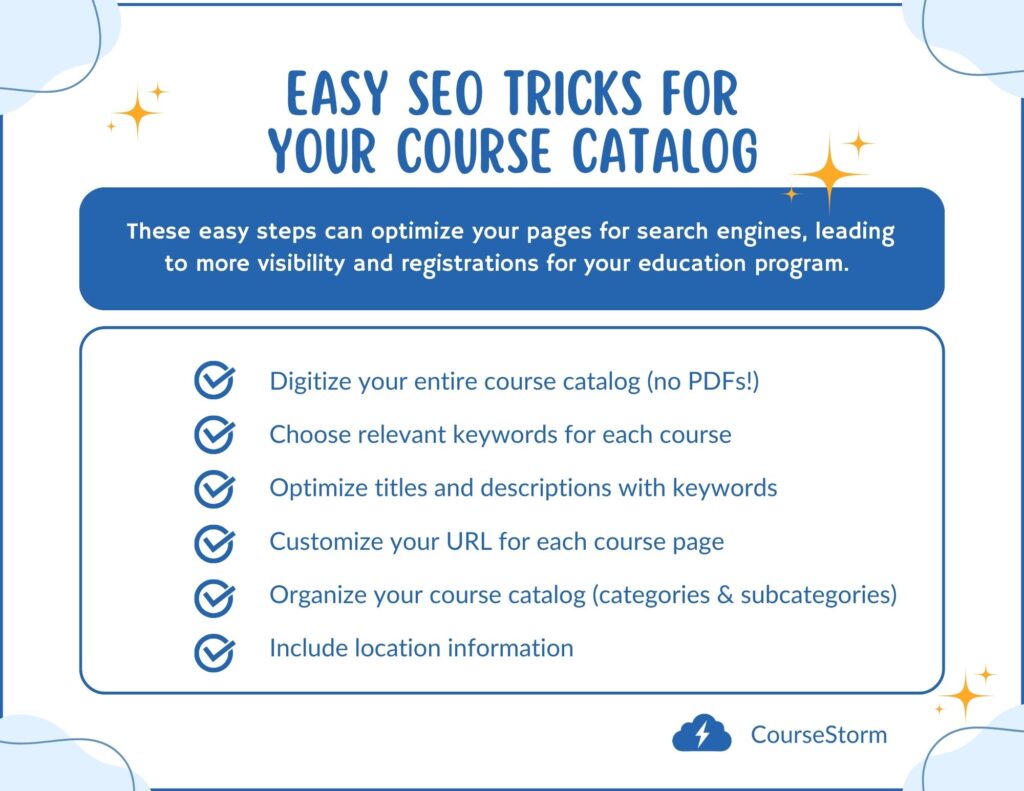Best Practices
Grow Your Program
How To's
6 Easy SEO Tricks to Make Course Listings More Visible on Google

The secret to search engine optimization is that there is no secret. But a few easy SEO tricks can make your course listings more visible on Google. Not only will they help students find your course pages, they’ll also make those pages more user friendly and attractive for learners.
You might be wondering why we’re focusing on Google specifically. The answer is pretty simple — Google searches account for more than 85% of the global search market share. Optimizing for Google search is a high-impact way to increase the visibility of your courses across the internet.
We’re not going to tell you to hire a pricey SEO firm or rebuild your entire website from scratch. Instead, we offer real changes you can make today to improve your SEO performance. Because when it comes to search engine optimization, small changes can make a big difference.
What Is Search Engine Optimization?
Let’s start by defining our terms. Search engine optimization is the content, formatting, programming, and hosting decisions that help you show up first in search engine results.
For the purposes of this guide, we’re going to talk mostly about on-page SEO. That is, the changes you can make to content on individual pages of your website to improve your ranking. We’re not going to get into programming and web development. Although, if you really want to up your SEO game, your web developer probably has some suggestions.

Easy SEO Tricks to Quickly Make Course Listings More Visible
These easy SEO tricks can apply to any page on your website, but we’re talking about how they can help with course listings because increased course page visibility often leads to more registrations for your program.
1. Digitize Your Entire Course Guide
Printed course guides are still a powerful tool. Sending them directly to potential students can help interest them in your programs, but a print catalog can’t improve your SEO. Some programs try to get away with uploading their course catalog as a PDF on their website, but that won’t help either.
Uploading your course catalog as a PDF does not help SEO since search engines can’t read the contents of PDF files.
First, search engines can’t read the contents of PDF files. When your course catalog is a PDF, you miss multiple opportunities to rank in search for course types and individual classes. Second, it creates an accessibility barrier. Some people are anxious about downloading files that could potentially infect their computers. Others don’t have the bandwidth for big downloads.
Worse, if someone is visually impaired, their assistive tools may not be able to read all PDFs.
When people can’t read your content, they’ll spend less time on your site, which means Google will assume you were unable to meet the user’s needs. The search engine will be less likely to show your content in future searches.
So, putting your course catalog online is good for potential students and for SEO. Without this step, none of our other easy SEO tricks really matter.
2. Choose Keywords That Fit Each Course
Keywords are a core element of search engine optimization. Search engines look for keywords to tell them what a page is about. If the keywords on your page match the ones a potential student typed into their search engine, you’re more likely to rank. Keep in mind that the most powerful keywords aren’t individual words at all. They’re keyphrases. For the blog post you’re reading now the phrase “easy SEO tricks” was one of our keywords.
The most powerful keywords aren’t individual words, they’re keyphrases. Aim for at least 3 per page.
For each page of your course guide, you should have a minimum of around three keywords. One, the primary keyword, should tell visitors the topic of your course. You can mix in a few secondary keywords to add context.
For example, if your keyword is “Beginners Acting Class for Kids,” you might include phrases like:
- Drama class
- Acting training
- After-school activities
- Improve public speaking
You can use Google Trends or other keyword research tools to find the right words.
3. Optimize Titles and Descriptions
The most powerful place to include keywords is in your title. Let’s say you have a course that helps behavioral health professionals get certified. Your title should probably include phrases like Behavioral Health Professional Certification Training or Certification Training for Behavioral Health Professionals.
Your secondary keywords can show up in your description. Don’t get carried away here. In the early days of SEO, the more you used a keyword, the better you ranked. Now, it’s all about context.
Your course description should be interesting and informative. Any keywords it uses should be grammatically correct and make sense in context. They should help the visitor understand what the class is about and whether it’s the right choice for them.
4. Customize Your URL for Each Course Listing
This is an easy SEO trick that many people miss. Every page in your course guide has a unique web address. It probably looks something like this: https://coursestorm.yourprogram.org/course/name-of-course/
Make sure that the slug, or URL, for each course page contains your keywords.
The part we’re interested in for SEO purposes is the text between the last two backslashes. This is known as the slug, and it’s a unique identifier for your page. You want to make sure that the slug includes the keywords for your course. So, if you have a course on How to Draw Animals your slug should be something like /how-to-draw-animals/.
Here’s what to avoid when choosing a slug:
- Don’t use an internal course number. /290340u57/ might make sense to you, but it doesn’t tell Google anything about your course
- Keep it short. /how-to-draw-cats-dogs-chickens-pigs-with-artist-sarah-smith/ is too much and misses the keyphrase
- Use real words and recognizable phrases, i.e. don’t shorten how to draw animals to /hw-to-drw-anmls/
Most website content management software includes an option to customize your slug. Take the extra moment to do this and you’ll instantly improve SEO.
5. Organize Your Course Catalog in a Meaningful Way
Google doesn’t just look at individual pages. It also considers how those pages fit together. This is another case where improving SEO also improves the user experience. When you organize your course content in logical ways, both Google and your potential learners can easily find what they’re looking for.
Organize your course guide into logical categories and subcategories. Categories might include broad topics like:
- Career Development
- Personal Enrichment
- Business and Skills Training
- High School Completion
- Technology
- Summer Camps
- Health and Fitness
Subcategories are more focused but still encompass multiple classes. So under Personal Enrichment you may have subcategories like:
- Arts and Crafts
- Cooking
- Outdoor Experiences
- Personal Finance
Try to choose categories and subcategories that your average student (or their parent) might search for.
6. Include Location Information
Mentioning the city and state where your class is located can make your listing more likely to rank for “near me” searches. So if someone types in “personal finance classes near me” your course listing is more likely to pop up in their search.
Skip this step, and you could be left off the list. It’s probably not enough to include the location of your organization on the contact us page. Make sure it appears on every course listing.
Think Beyond Easy SEO Tricks to Keep Improving
The easy SEO tricks we’ve shared here will get you started. They’re a quick way to improve user experience and get seen on Google. But they’re just the beginning. Keep in mind that SEO is always evolving. What works now may not be a best practice in three years. Watch the headlines to make sure you never miss an update.
CourseStorm can help you create a user-friendly, search engine optimized course catalog.
Our simple course registration software helps you stay organized, lets you customize your URL, and features location information for every class. For more tips on reaching more students, read our post on course catalog examples that boost enrollment.

Nic Lyons
Nic is skilled in scaling start-up edtech and education organizations to growth-stage success through innovative marketing. A former journalist and copywriter, Nic holds a postgraduate certificate in digital and print publishing from Columbia University School of Journalism's publishing course.
